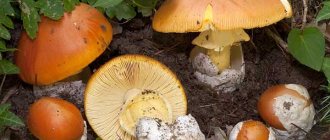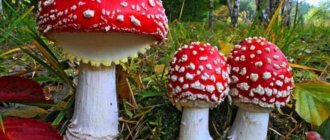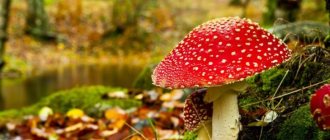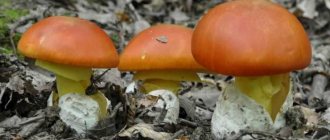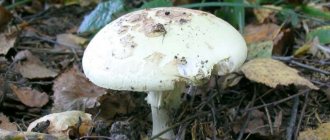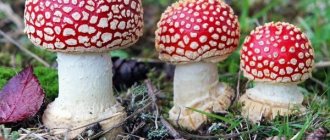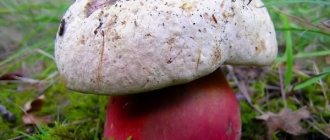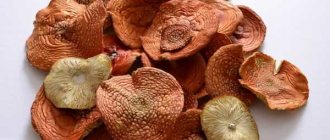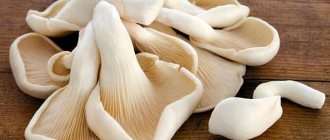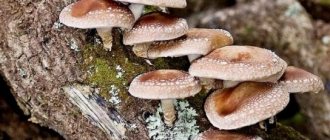Most people know that there is a type of mushroom on earth called fly agaric, with a red cap and white specks. These mushrooms are often mentioned in cartoons, fairy tales and books. And this is not done in vain, since such a beautiful mushroom can cause a lot of harm to people and animals.
For children, why the fly agaric is called “fly agaric”, you can provide information from books: “The fly agaric is beautiful and red, but dangerous for people.”
Any child can see this beautiful mushroom on the street and taste it.
Where does this name come from?
Why was the fly agaric called "fly agaric"? This name was popularly given due to its use for sanitary purposes. To kill insects, flies and bedbugs. That is why the fly agaric was called “fly agaric” (“fly” and “pestilence”). There are many varieties of this mushroom, but only the red type, the same one that we often see in pictures and cartoons, can help in destroying insects. Due to the acid and toxic substances they contain, these mushrooms can lead to changes in mental state, including clouding of consciousness and convulsions, causing nausea, vomiting, low blood pressure, suffocation and even death.
Useful killer. How did the fly agaric get its name and is its reputation justified?
Anyone who knows the most basic information about wild mushrooms knows why the red fly agaric got its name. This mushroom kills flies that feed on it; up to our time in Europe it is used as a household insecticide. This information is in all books.
Moreover, in a large part of European territory, uneducated peasants who do not read books take this statement as folk wisdom. It belongs to those curious facts that people pass on to each other and believe in without bothering to analyze and verify them. <…>
Ancient authors, although they talk a lot about mushrooms, never mention the fly killer; in modern Italy, it seems to us, fly agaric does not cause associations with flies among the rural population, but we do not pretend to be fully aware of this issue.
The Basques and, obviously, the entire rural population of the Iberian Peninsula know nothing about this. According to the testimony of Eugene Rolland in his work "Popular Flora", in France the name "tue-mouche" ("killer of flies") is usually used only by the inhabitants of Alsace and the Aude department, although thanks to mushroom reference books it has now become widespread among educated people throughout country.
According to Rolland, in the commune of Le Val-d'Ajol in the Vosges, local residents hang red fly agaric mushrooms from the ceiling, where they, as they put it, “suck the flies to death.”
In contrast, variants of the German term "Fliegenschwamm" ("fly mushroom") are present in all dialects, as well as in Dutch and the Germanic languages of Scandinavia, but not in English ("fly agaric" and "fly amanita" are innovations made by scientists over the past two centuries).
Russians say "fly agaric", that is, "killer of flies", and such parallels can also be found in the languages of other Slavic peoples.
In short, the red fly agaric is associated with flies almost exclusively in the languages of the Germanic and Slavic peoples of northern Europe. We can trace this connection back over six centuries.
In this series of quotations we are going to document these folk beliefs from the Middle Ages to the age of science. We will prove that this information has stood the test of time, and we will show that long-standing and seemingly indisputable truths may be only partially true, or may turn out to be completely incorrect.
The earliest mention of the red fly agaric is found in De Vegetabilibus (On Plants), a fundamental work on the plant world; It was created in the 13th century by Albertus Magnus. It mentions this mushroom twice and both times notes its ability to kill flies. The following quotations are taken from the Berlin edition of Karl Essen (1867, pp. 136 and 517).
Tuber enim, quod vocatur muscarum, venenosum est; et si lacti immisceatur, et muscas cadant super lac illud, gustantes ipsum, inflantur et moriuntur. Est autem illud tuber in superficie latum, et ad rubedinem declinans, habens in superficie ampullas, sicut sunt ampullae in pelle valde leprosi hominis, in quibus non est humor, sed ventositas quaedam interclusa.
The mushroom, called “fly mushroom”, is poisonous; if it is mixed with milk, then the flies that flock to this milk and drink it swell and die. This mushroom is bright, usually red in color. It has bubbles on its skin, similar to the bubbles on the skin of patients with leprosy in the last stage, but they contain no moisture, only gases.
In nostris autem habitationibus invenitur fungus, qui latus est et spissus, aliquid ruboris habens in superficie, et in illo rubore habet multas ampullas elevatas, quarum quaedam fractae sunt, quaedam non: et ille mortalis est, et statim interficiens, et vocatur fungus muscarum, eo quod in lacte pulverizatus interficit muscas.
In our places of residence, in addition, they find bright and large mushrooms with a reddish cap, on which you can see many clearly visible bubbles; some of them burst, some remain intact. These mushrooms are deadly poisonous and kill instantly; for this reason they are called fly mushrooms: if they are crushed and mixed with milk, they kill flies.
A century later, in 1349–1350, another German named Conrad von Megenberg wrote The Book of Nature (Das Buch der Natur), the earliest work in the German language dealing with the natural sciences. He devotes one of the paragraphs to mushrooms and ends it with several original judgments about Amanita muscaria in the Bavarian-Austrian dialect. In particular, he states (quoted from the 1475 edition):
Es ist auch einer anderley schwammen die seind zuomal unreyn die seind breit und dick und oben rot mit weyssen bleyterlen. Wann man die zuo milch mischt so deet er die muggen. Darumb heyssen es muggennschwammen. Und zuo latein mustineti.
There is another mushroom that is definitely unclean. It is bright in appearance and has white spots on its red cap. When mixed with milk, it kills flies. Therefore, they are called muggenschwammerl (i.e., fly mushroom), in Latin - mustineti.
Read the interview with Mikhail Vishnevsky
Underwater mushrooms, fly agaric mash, gasoline slavery and other stories from mycologist Mikhail Vishnevsky
Valery Kord, our third author, is also German; he is sometimes called the founder of modern pharmacology. Contemporaries considered his sudden death in 1544 (he was only 29 years old at the time) an irreparable loss. In his book “Annotationes” (“Notes on Dioscorides”), he, among other things, devotes one paragraph to mushrooms; and in one phrase he mentions the red fly agaric. In this text we find the earliest use, as far as we know, of the modern German term "Fliegenschwamm":
Sub Betulis arboribus in candido & rufo colore varii nascuntur Fungi, quos Fliegenschivemme,id est, Muscarios fungos vocamus, quoniarn muscas lacte intriti occidunt.
Under the birch trees grow various red and white mushrooms, which we call Fliegenschwamm, that is, fly mushroom, because if they are mashed in milk, they kill flies.
The founder of mycology is often credited to Charles de Lecluse, a Frenchman from Arras, whose contributions to botany make him a major figure in this field of knowledge. In 1601, his book Rariorum Plantarum Historia was published in Antwerp; in this important work a large section was devoted to the mushrooms of Hungary (or Pannonia, as the region was then called).
Charles Clusius (by which name Lecluse is better known) was the first author to take a closer look at them, describe them with the accuracy of an eyewitness, and publish his own observations about them. His description of the red fly agaric is notable for its accuracy; in addition, he also mentions flies:
Invenitur etiam hsec species in caeduis silvis Francofurto ad Mcenum vicinis, unde rustics mulieres lectam, in urbem deferunt venalem, cum non ignorent plerosque empturos ad muscas necandas: nam cum, ut dixi, muscse libenter illi insideant, divulsam in fragmenta, varijs in conclavi locis ante fenestras spargere solent, ad quae invitatae & excitae muscas, succum sugunt ipsis perniciosum, & paulo post etiam lethalem.
These mushrooms are often found in old forests around Frankfurt am Main, where they are collected by peasant women and taken to the city for sale. Most buyers are familiar with them and buy them to kill flies.
Since, as I said earlier, flies like to land on them, people scatter pieces of these mushrooms on the floor, scatter them under the windows. Attracted by their smell, the flies drink the mushroom juice, which is poisonous to them, and soon die.
Albertus Magnus, von Megenberg, Valery Kord, Charles Clusius - this entire impressive cohort of authors testifies in favor of the traditional view of the red fly agaric. Critics of this approach, however, have some reservations. All four authors were German or wrote from German experience.
Why is the same phenomenon not described by authors who wrote in Greek, Latin, French and Italian? The reliability of Albertus Magnus' information can be questioned if one pays attention to his description of the mushrooms: Amanita muscaria does not have vesicles, like those of leprosy patients.
This versatile polymath seems to have never looked closely at the mushrooms described; in any case, part of what he claims is just rumors. Von Megenberg also deserves a dose of skepticism.
Immediately before the verbal portrait of red fly agarics, he gives a description of another mushroom - Pfifferling, as Lactarius piperatus was called in his time, and erroneously claims that it is a deadly poisonous mushroom. Here is a translation of his words:
“Caution must be exercised, as they are quite poisonous and can cause a fatal illness in humans... An example of this is known in Austria: a man ate a dish of Pfifferling, washed it down with strong mead and died immediately while sitting in front of a barrel. The true truth, by God."
As witnesses, both Albertus Magnus and von Megenberg might not have stood up to cross-examination by opposing counsel: their notes were a mishmash of scientific information and contemporaneous rumors.
How has the mushroom been used before?
During the Middle Ages, in order to get rid of insects, fly agaric was cut into small pieces, poured with milk and placed in several places in the rooms. After eating this delicacy, the flies fell asleep and drowned in the milk.
But these are not all methods of application. This mushroom has long been used during religious celebrations by the peoples of the North and Siberia as an intoxicant. Its effect was reminiscent of very strong intoxication. There was an alternation of laughter and anger, hallucinations and doubling of objects, loss of consciousness and sleep, followed by amnesia.
Various sources describe what happens to people after consuming this mushroom. At first they are dexterous, strong and cheerful. Then comes the next stage, where hallucinations appear. People hear voices, see changed objects, but can still speak and understand everything. At the end of the third stage of intoxication, lethargic sleep occurs.
Popular topics today
The Republic of Bashkortostan is a subject of the Russian Federation, which is included in the Volga Federal District of the Russian Federation.
There is probably no person in the world who has never heard of such a great navigator as Ivan Fedorovich Krusenstern. Not only was this person a member of scientific
Potatoes are a very common tasty and nutritious vegetable. Belongs to the Solanaceae family. South America is considered the birthplace of potatoes. It is from here that this vegetable first appeared in Europe
If you ask about a bird's traits, many people will answer that "they fly." However, not all birds fly, and each bird's wings have the most suitable shape for their lifestyle. For example, al
Vasily Andreevich Tropinin occupies a special place in the history of fine arts. He was born in 1776 into a peasant family. In 1823, the artist received his freedom certificate
The name of the perennial plant is due to the legend according to which the goddess of beauty Venus lost her shoe when she was running away from her pursuers. Lady's slipper is a real long-liver
Source
Where does the edible fly agaric grow?
Some types of this mushroom are even considered delicious, but you need to take into account that they are not found in Russia.
The mushroom grows in light mixed forests in North America. In the 20th century, this mushroom was discovered in South Africa. Usually, like many mushrooms, it is fried after boiling. It is also consumed pickled and salted, and can be frozen. Its taste is reminiscent of chicken.
This species also has medicinal properties, thanks to the substance betaine.
Report-message Fly agaric (2nd, 3rd, 4th, 5th grade biology)
Fly agaric is one of the most recognizable among mushrooms. It owes its popularity to its pronounced color - a red cap strewn with white spots.
The red cap of a mushroom is a signal of danger. This mushroom is very poisonous, as it contains the following deadly chemical elements: chitin, xanthine, ibotenic acid and others. It also contains a number of psychotropic and hallucinogenic substances (muscarine), which are concentrated in its cap. These components, when consumed, cause hallucinations in humans. Their highest concentration is observed in the white dots on the cap. However, despite this, the fly agaric has several varieties, a couple of which are edible. But you should be careful when collecting. If you do not have accurate knowledge, then it is not worth the risk. An interesting fact is that the fly agaric mushroom is an excellent food for wild animals.
The fly agaric belongs to the toadstool family. This mushroom is frost-resistant. It appears at the end of July and grows until persistent frost appears. Its usual habitat is the pine forests of North America, Siberia and Europe. The average size of the mushroom is in the range from 5 to 20 cm, and the diameter of the cap is from 8 to 20 cm. The peculiarity of this representative is that the cap changes its color. With heavy rain, old mushrooms turn brown.
Despite the fact that the mushroom is poisonous, it also brings benefits to humans. Fly agaric is often used in pharmaceuticals. It is the basis for the manufacture of drugs against ODS, in particular sore throat. Widely used to make medicines, ointments against varicose veins.
Our ancestors used this mushroom as a folk medicine. Special decoctions could save a person from coronary heart disease and hypertension.
Scientists have found that using fly agaric in food at the correct dosage leads to the restoration of the human nervous system. Some tales tell of fearless Vikings who are famous for their strength. Their secret lies in the potion. They used it before the fight. The potion was prepared from fly agaric.
But you should know that eating fly agaric mushroom in its raw form is strictly prohibited, as you can get severe poisoning, possibly even fatal.
Description of fly agaric
To make it more interesting to remember what a fly agaric looks like, I decided to make it out of plasticine. To make a plasticine mushroom look like a real mushroom, I found its description on the Internet.
First I sculpted the fly agaric leg. Fly agaric is a fairly large mushroom with a fleshy body and a stalk. The leg usually widens downward. There is a “skirt” on it. I rolled white plasticine into a cylinder. I made a small sausage from white plasticine and flattened it. I connected a flattened strip with a cylinder leg, creating a fly agaric “skirt”.
The color of the fly agaric depends on its type and age. Amanita caps can be red, yellow, white, green, brown, orange.
I decided to make a regular red fly agaric. The hat is shaped like an umbrella. I made a cone out of red plasticine. Use your finger to make a notch in the cone, slightly flattening the edges. In young fly agarics, it has the shape of a dome. With age, the cap straightens and becomes flat. The cap of an adult fly agaric can be 15-20 cm in diameter.
I molded a ball out of white plasticine, flattened it into a cake and stuck it to the inside of the cap and applied notches-plates with a stack. Fly agarics have a beautiful bright cap of red or reddish color, strewn with white grains.
They also say that the designers came up with polka dot fabric while looking at fly agarics.
I got a very beautiful fly agaric! It is not for nothing that among all mushrooms, fly agaric stands out for its bright appearance. It's a pity, but it will never end up in the mushroom picker's basket. Fly agaric mushrooms cannot be collected or eaten because they are poisonous. Therefore, it is best to simply admire the fly agarics in the forest.
And I put my fly agaric on the shelf next to our other crafts.
Conclusion
The goals and objectives of my project have been achieved.
Practical significance of the study : this material can be used in lessons about the surrounding world, during class hours and quizzes.
Internet resources were used to write this project.
Source
Features, appearance
The fly agaric mushroom belongs to the Amish agaric mushrooms; its scarlet cap with white dots can never be confused with any other mushroom. As it develops, the mycelium or mycelium forms a symbiosis with the roots of a variety of trees.
Therefore, you can find fly agaric in a spruce forest, birch forest, aspen forest, oak grove - everywhere this mushroom will find its place. It can also form a strong union with plant roots.
Types of fly agaric differ from each other - now more than six hundred of its varieties have been found all over the world. Moreover, the cap is not always bright red with dots of light color or white; it can be light yellow, brownish, and even white. The most common fly agarics are red and panther, you can also see royal ones, but less often.
What does it look like?
The mushroom is quite large, the leg of the fly agaric is light in color; closer to the ground it will be wider and narrower towards the cap. Under the cap there are plates and there may be small rags that formed during its growth. You can also find the remains of the “skirt” or even its entirety - it covers the spores that ripen in the plates of the fungus. The fly agaric itself looks fleshy and powerful.
Not all people know that the most poisonous mushroom in our country, and not only in ours, is the toadstool, also from the fly agaric family. So in this article it would be wrong not to say at least a few words about it.
Pale toadstool is a rather large mushroom with a rounded cap up to fifteen centimeters in diameter, the stem of an adult mushroom is also about twelve centimeters long. The mushroom is so poisonous that one in a pan is enough to kill anyone who tries this soup. This toadstool has a film under its cap, by which it can be distinguished from other mushrooms, but it is still confused with the same champignons and not a year goes by without someone getting poisoned.
Signs of poisoning appear after a few hours, when it is almost always too late to save a person and the same liver is almost completely destroyed by toxins. So be careful when picking mushrooms and don’t think that the fly agaric is just that mushroom with a bright red cap.
Properties of fly agaric and toxins
The properties of the red fly agaric or any other type of this mushroom are similar. It has several different toxins that are found throughout the body of the mushroom, including the stalk, although there are usually slightly fewer toxins there.
The red fly agaric contains the following substances:
- muscimol is a powerful hallucinogen that disrupts connections between neurons in our brain, causes hallucinations, and has a hypnotic and sedative effect;
- Ibotenic acid is a toxin that has an extremely detrimental effect on the brain, destroying neural connections and killing the neurons themselves;
- muscarine is probably the most well-known mushroom toxin to most people, which has a strong vasodilating effect, thanks to it arterial blood pressure drops, the heart begins to work intermittently, and a clinical picture of poisoning occurs with nausea, vomiting, dizziness;
- muscaruphine is the only beneficial property of fly agaric, the substance is an antibiotic, also has an antitumor effect and relieves inflammation;
- muscazone - a consequence of the breakdown of ibotenic acid, also affects the central nervous system, but more weakly.
The fly agaric is the most poisonous and dangerous throughout the warm season, from the beginning of June until the first frost - it contains the most toxins at this time of year.
Forest animals feast on fly agarics without harming themselves
0
Source:
It is unknown when this myth originated. Ancient authors often wrote about mushrooms, but they never mentioned killing flies. We can say for sure that in modern Italy and Greece, the rural population has not heard anything about the insecticidal properties of this poisonous mushroom. The Basques and, in general, the entire population of the Iberian Peninsula do not know about it. At the same time, biologist Eugene Rolland, in his work “Popular Flora,” noted that in France the name “tue-mouche” (“fly killer”) is often used by villagers in Alsace and the Aude department, bordering Germany. With their light hand, the name “fly agaric” found its way into most mushroom reference books in France, and only educated people use it. Rolland writes that in the commune of Le Val d'Ajol in the Vosges, in some peasant houses, red fly agaric mushrooms are hung from the ceiling because they believe that they are able to “suck the life out of flies.” But this is a regional phenomenon and has nothing to do with the entire population of France.
×
